
Wine Culture and Information since 2002 - Volume 23
 Wine Culture and Information since 2002 - Volume 23 |
|
Tasting Rose WinesRose wines are often neglected and not very appreciated, however they are pleasing and can give sensations which remind fruit's freshness |
|
Among the types of wines produced, roses are certainly the most neglected and least appreciated wines, they practically are hidden between white wines and red wines, however they are the perfect element which connects the two most common style of wines; when a white wine is “not enough” and a red wine is just “too much”, rose wine represents the ideal solution. It should be however remembered that the category of rose wines has been underrated in the past mainly because of a certain kind of restaurants, when they used to mix, without any kind of scruple, reds and whites together therefore creating a very bad quality product which certainly did not help to the success of rose wines. It must also be remembered there is a specific law, in force in almost every wine producing country of the world, which forbids the production of rose wine by mixing white and red wines, therefore this is a prejudice to be abandoned. Whether this is a warrant offered by any serious rose wines producer who sells its wine in sealed bottled, the same is not always guaranteed, unfortunately, for non bottled wine. In order to provide a complete information, it should be remembered that the mixing of white wines and red wines is only permitted for the production of rose sparkling wines elaborated with the classic method. Rose wines should be reevaluated and considered as real and proper wines, by recognizing them their status of real wine and this is not what unfortunately is happening. Rose wines are produced with proper and specific methods, just like for white wines and red wines or sparkling wines. The agreeability of these wines, to be consumed in their youth, in their best time, can be compared to the one of white wines; practically no rose wine is suited for the aging in bottle and they are wines expressly produced for being consumed soon after they are released on the market, after all, the same can be said for most of white wines. The reason why rose wines are not suited for the aging in bottle is because of the lack of preservative substances: these wines are generally less acid of whites and contain a quantity of tannins very inferior to the one of red wines. As rose wines should be consumed in their youth, they can give pleasing and fresh sensations, usually of fruit, that cannot be generally found in other kind of wines: a good reason for properly considering and reevaluating this too much neglected category of wines.
|
|
Contrary to the other types of wine, in general terms, the color in rose wines has no connection with aging, as they are usually consumed within one year or two from their production, indeed they are a sign of the technique used for their vinification, the grapes used and the area of origin. However these wines tend with time to get brown colors and nuances, a signal which indicates, not only the excessive aging, but also and particularly its oxidization, mainly because of the bad keeping practices and of high temperature. The main factor which determines the color in rose wines is the technique used for their production. There are two main systems for the production of these wines, both to be considered as real and proper vinification techniques. The first one consists in softly pressing red berried grapes in order to get a lightly colored must and soon after separated from skins. The second technique consists in macerating the skins on the must, just like any red wine, and allowing the contact for a relatively short period of time and enough to color the wine according to the type of product to be made. Using this method also adds a higher structure to the wine because of tannins being extracted from skins. The usual time spent for maceration is of about 6-12 hours, in this case wines are called “wines of one night”, up to 24 hours for wines called “wines of one day”. At the end of these initial procedures, vinification is completed by means of the usual white wine making techniques. Rose wines are not to be considered as “hybrid” wines or low quality red wines, they are real wines and produced with specific techniques. Defining a range of color for rose wines is pretty hard because their color is determined by many factors, in particular by the vinification technique, therefore the time of maceration and the species of grapes used. Typical colors can range from light pale pink up to light red, with a vast range of nuances in between. Evident orange, yellow or brown colors or nuances are usually the sign of an oxidized wine or however an excessive aging and these colors should never be found in a rose wine. A quality rose wine should always have a firm pink color, with no evident nuances, not excessively red, and even though this is not generally wished, a light nuance of orange or blue is however acceptable. Brown colors or nuances, and however colors resembling brown, are always and however to be considered as a negative factor, sign of oxidizations or excessive aging, in practice, the presence of this color is a clean sign that the wine has lost its best organoleptic qualities. The intensity of color in rose wines is generally a sign of the vinification technique used: wines made by just pressing grapes are lighter and paler than the ones produced with maceration.
|
||||
|
The main characteristic every rose wine should have is aromaticity. Despite the fact these wines does not usually have a considerable structure, the most pleasing aspect of tasting rose wines is certainly represented by their aromas. Considering the habit of consuming these wines when they are young, talking about the evolution of aromas in rose wines does not have any practical use, mainly because these wines offer their best organoleptic characteristics during their youth. Aromas of rose wines seems to be the connection point between white wines and red wines, in this type of wines there can be perceived the typical aromas of white wines as well as of red wines, therefore they will be typical aromas of rose wines. Aromas of flowers and fruit will be the most common types, however, according to the quality of grapes used, there can be perceived vegetal aromas as well and in the not so common case a producer decided to age its rose wine in cask, there can also be perceived spicy and toasted aromas. Even the most typical aromas in rose wines, the ones belonging to the family of flowers and fruit, mainly depend by the quality of the grapes used for their production, however the aromas that will be perceived will be similar to the ones of white and red wines produced with the very same grapes. Sometimes can also be found vegetal aromas, in particular aromas of bell pepper, walnut-husk and black currant leaf. Aromas of dried fruit are pretty rare in rose wines, however in many of them it is possible to perceive a clear and evident aroma of almond. Among the most common flower aromas in rose wines there are rose, violet, dried rose, hawthorn, wild rose, dog rose, peach flower, wild flowers, peony, jasmine, freesia, orange blossom, lime and broom. Among fruit aromas there are cherry, strawberry, raspberry, peach, black cherry, black currant, blackberry, banana, apple, plum, pear, blueberry, apricot, kiwi, medlar, pomegranate, orange, tangerine, grapefruit, litchi and pineapple.
|
|
Just like aromas, taste in rose wines must be pleasingly fresh as well; a rose wine lacking in acidity will always be flat and not very interesting, however a too much acid rose wine will be unpleasing and too much aggressive. Balance in this type of wine must be evaluated according to the production technique. The element which will be always present, certainly in proper and right quantities in order to balance its opposing elements, will be alcohol, useful in balancing acidity and any possible astringency because of tannins passed to wine during maceration in skins. Astringency in rose wines, when present, will always and however be moderate, far lower than the one of red wines, however, when it is present, acidity must be lesser. Even in case a rose wine has a perceptible astringency, acidity will however be the characteristic to be favored the most, just because everyone expects this characteristic from a rose wine. Even the taste-olfactory correspondence is a characteristic that should be common in these wines. In the mouth rose wines must have the freshness of flowers and fruits that was perceived by the nose, certainly completed by a pleasing crispness. Tannins will contribute to give body to the wine, however this aspect must not be excessive in order not to have a heavy and unpleasing wine.
|
|
In order to better understand rose wines, we will now have a comparative and practical tasting of three wines produced in different areas. To do the practical application explained in this section we will need a bottle of “Bardolino Chiaretto”, a rose wine from Salento and, lastly, a “Cirò Rosato”, all wines being of the latest vintage. These three Italian wines are produced with different grapes and in different areas: Bardolino Chiaretto is a wine from Veneto and is usually produced with Corvina, Rondinella and Molinara grapes; Salento Rosato is produced in Apulia with Negroamaro and Malvasia Nera grapes; whereas Cirò Rosato is produced in Calabria with Gaglioppo grape. The three wines will be served at temperatures ranging from 12 and 14° C (53.6-57.2° F). In rose wines the temperature plays a fundamental role and will be essential in particular to the perception of tastes: lower temperatures will tend to favor the perception of acidity and tannins, whereas higher temperatures will tend to favor roundness. In the appearance the three wines show pretty typical colors: Bardolino Chiaretto shows a rose color which is lighter than the other two, with nuances of cherry red; Salento Rosato will show a more firm color, an intense pink with nuances of cherry red; lastly, Cirò Rosato will probably be the one having a deeper color compared to the other two, it will more likely to have a color similar to the one of Salento Rosato. To the nose the three wines will have the typical characteristics of rose wines: freshness, fragrance and evident aromas of fruit and flowers. Bardolino Chiaretto will have aromas more oriented to fruit, in particular, raspberry, strawberry and cherry, however it will not be rare to perceive aromas of freesia, hawthorn and violet as well. Salento Rosato will have aromas oriented to fruits such as raspberry, strawberry, almond and peach as well as flower aromas of rose, jasmine and violet. Cirò Rosato will mainly characterized by fruit aromas, in particular cherry, raspberry, black cherry, strawberry and, sometimes, banana and peach as well. In this wine can also be perceived an aroma of rose. In the mouth the three wines will be very agreeable and pleasing, with a pretty evident freshness and crispness. Bardolino Chiaretto will be rounder, if compared to the other two, whereas Salento Rosato will seem to have a higher structure because of the higher contents in tannins, even though it will be the freshness to prevail over the other tastes. The same sensation will also be found in Cirò Rosato. The three wines will however be balanced and it will be interesting to paying attention to the evaluation of the intensity of acidity and astringency in regard to balance. The taste the three wines will leave in the mouth will be very agreeable with evident flavors of fruit and it will also be possible to perceive a clean flavor of almond.
|
Wines of the Month |
|
|
|
Score legend Prices are to be considered as indicative. Prices may vary according to the country or the shop where wines are bought |
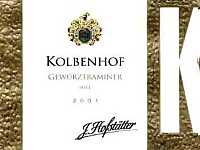
|
|
Alto Adige Gewürztraminer Kolbenhof 2001 |
|
| Hofstätter (Italy) | |
| Grapes: Gewürztraminer | |
| Price: € 19,30 | Score: |
| The wine is crystalline with an intense straw yellow color and nuances of straw yellow, very transparent. The nose is elegant, refined and of great personality with intense, rich, clean and persistent aromas such as apricot, pineapple, banana, passion fruit, broom, kiwi, litchi, honey, pear, peach, sage as well as an intense and pleasing typical aroma of the grape. In the mouth has an excellent correspondence to the nose and a magnificent balance. Alcohol, present in good quantity, is perfectly balanced by wine's acidity, flavors are very intense and agreeable. The finish is practically endless, very long and with strong, agreeable and clean flavors of peach, banana, pear, kiwi, honey and litchi. Simply a magnificent wine. This wine is produced with a short maceration of must in skins followed by a fermentation at a controlled temperature. | |
| Food Match: Crustaceans, Roasted spiced fish, pasta and risotto with fish | |
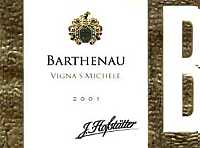
|
|
Alto Adige Bianco Barthenau Vigna San Michele 2001 |
|
| Hofstätter (Italy) | |
| Grapes: Pinot Blanc (70%), Chardonnay (25%), Sauvignon Blanc e Riesling (5%) | |
| Price: € 16,50 | Score: |
| The wine is crystalline with a straw yellow color and nuances of greenish yellow, very transparent. The nose reveals an aroma of wood, very refined and well integrated with other aromas and not intrusive at all. There can be perceived good and intense aromas of banana, hawthorn, litchi, apple, pear, peach, elder flower and vanilla, all very elegant, refined and pleasing. In the mouth is balanced with excellent correspondence to the nose, intense and crisp. Very agreeable. The finish is persistent with elegant flavors of vanilla, pear, apple and peach. A good wine. This wine is produced with fermentation of the grapes, part in steel tanks and part in barrique. | |
| Food Match: Appetizers, Risotto and pasta with fish, White meat | |
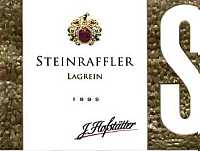
|
|
Alto Adige Lagrein Steinraffler 1999 |
|
| Hofstätter (Italy) | |
| Grapes: Lagrein | |
| Price: € 25,70 | Score: |
| The wine shows a beautiful and intense ruby red color and nuances of ruby red, moderate transparency. The nose reveals a long series of intense, complex, rich and pleasing aromas as well as good personality. There can be perceived good aromas of black cherry, anise, cocoa, coffee, toffee, carob, cherry macerated in alcohol, licorice, blueberry, black pepper, plum and vanilla. In mouth denotes a slightly crisp attack however well balanced and good correspondence to the nose. Smooth and agreeable tannins, intense flavors. The finish is persistent with good and pleasing flavors of black cherry, toffee, coffee and plum. A well made wine. This Lagrein is aged for 15 months in barriques, 6 months in casks and for at least 12 months in bottle. | |
| Food Match: Game, Hard cheese, Braised meat, Stewed meat | |
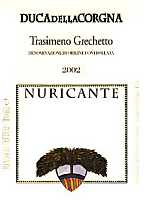
|
|
Colli del Trasimeno Grechetto Nuricante 2002 |
|
| Duca della Corgna (Italy) | |
| Grapes: Grechetto | |
| Price: € 4,80 | Score: |
| The wine shows a light straw yellow color and nuances of greenish yellow, very transparent. The nose reveals good personality with elegant, pleasing, intense and clean aromas of banana, hawthorn, kiwi, apple, honey, hazelnut, pear and citrus peel. In mouth has good correspondence to the nose and good balance, intense flavors and agreeable. The finish is persistent with flavors of pear and apple. Part of the must used to make this wine is fermented in barrique. | |
| Food Match: Fish appetizers, Pasta and risotto with fish, Roasted fish, Sauteed white meat, Soft cheese | |
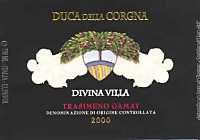
|
|
Colli del Trasimeno Gamay Divina Villa Etichetta Nera 2000 |
|
| Duca della Corgna (Italy) | |
| Grapes: Gamay | |
| Price: € 9,20 | Score: |
| The wine shows an intense ruby red color and nuances of ruby red, moderate transparency. The nose denotes intense, elegant, clean and pleasing aromas of black cherry, blackberry jam, raspberry, plum and black currant followed by pleasing aromas of licorice, violet, eucalyptus and vanilla. In mouth reveals good correspondence to the nose, an alcoholic attack however well balanced by tannins, intense flavors and good body. The finish is persistent with pleasing flavors of plum, black cherry and black currant. A well made wine. This Gamay ages for about 12 months in barrique followed by 7 months in bottle. | |
| Food Match: Game, Roasted meat, Braised meat, Stewed meat, Hard cheese | |
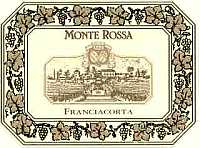
|
|
Franciacorta Prima Cuvée Brut |
|
| Monte Rossa (Italy) | |
| Grapes: Chardonnay, Pinot Blanc (85%) Pinot Noir (15%) | |
| Price: € 13,00 | Score: |
| The wine shows an intense greenish yellow color and nuances of greenish yellow, fine and persistent perlage. The nose reveals intense, pleasing and elegant aromas of citrus fruit, yeast, butter, hawthorn, almond, apple, pear, banana and peach. In mouth has good correspondence to the nose, a crisp attack however well balanced, appreciable effervescence, intense flavors. The finish is persistent with flavors of almond, citrus fruit and pear. This Franciacorta is produced with wines partially aged in barrique and stays in contact of the lees for at least 24 months. | |
| Food Match: Soft cheese, Pasta and risotto with fish, Crustaceans | |
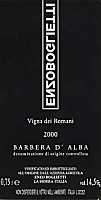
|
|
Barbera d'Alba Vigna dei Romani 2000 |
|
| Enzo Boglietti (Italy) | |
| Grapes: Barbera | |
| Price: € 33,00 | Score: |
| A magnificent Barbera! This wine shows a beautiful deep ruby red color and nuances of ruby red, little transparency. The nose reveals great personality with intense, clean, elegant and refined aromas where it can be perceived a clear hint of toasted wood which does not disturb the perception of other aromas. There can be perceived good aromas of black cherry jam, cherry jam, plum jam, raspberry, black currant and dried violet followed by good and intense aromas of cocoa, toffee, licorice, vanilla and toasted wood. In mouth reveals excellent correspondence to the nose, a slightly tannic attack however balanced by alcohol and acidity of Barbera. Intense flavors and full body. The finish is very persistent with long and clean flavors of black cherry, plum and toasted. A truly great wine and very well made. Vigna dei Romani is aged for 16 months in barrique and for 4 months in bottle. | |
| Food Match: Game, Braised meat, Stewed meat, Roasted meat, Hard cheese | |
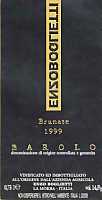
|
|
Barolo Vigna delle Brunate 1999 |
|
| Enzo Boglietti (Italy) | |
| Grapes: Nebbiolo | |
| Price: € 52,00 | Score: |
| Excellent Barolo! The wine has a beautiful and intense garnet red color and nuances of garnet red, moderate transparency. The nose reveals personality with intense, clean, pleasing, elegant and refined aromas of cherry, violet, strawberry jam, raspberry jam and plum jam followed by good and intense aromas of chocolate, leather, licorice, menthol, tobacco and vanilla. In mouth denotes a tannic attack however balanced, good correspondence to the nose, intense flavors and full body. The finish is very persistent with long and clean flavors of cherry, plum and raspberry. A great and well made wine that will give its best with further years of aging in bottle. This Barolo ages for 30 months in cask followed by 8 months of aging in bottle. | |
| Food Match: Game, Braised meat, Stewed meat, Roasted meat, Hard cheese | |
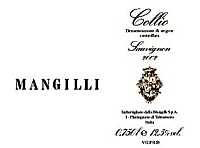
|
|
Collio Sauvignon 2002 |
|
| Mangilli (Italy) | |
| Grapes: Sauvignon Blanc | |
| Price: € 7,60 | Score: |
| The wine shows a light straw yellow and nuances of greenish yellow, very transparent. The nose has personality with elegant, intense, clean and pleasing aromas, mainly of flowers, such as chamomile, chrysanthemum, carnation, yellow rose and elder followed by good aromas of apple, pear, peach, tomato leaf, bell pepper and basil. In the mouth is balanced, very agreeable with intense flavors. The finish is persistent with flavors of apple, peach and pear. A well made wine. This Sauvignon Blanc is fermented in steel tanks and ages for at least 30 days in bottle. | |
| Food Match: Appetizers, Fish, Crustaceans, Pasta and risotto with vegetables and fish | |
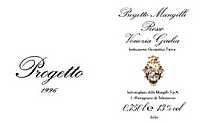
|
|
Progetto 1996 |
|
| Mangilli (Italy) | |
| Grapes: Cabernet Sauvignon (60%), Cabernet Franc (20%), Merlot (20%) | |
| Price: € 14,30 | Score: |
| The wine has an intense ruby red color and nuances of garnet red, little transparency. The nose reveals personality with intense, clean, elegant and refined aromas of black cherry, strawberry jam, raspberry jam, blackberry jam, plum jam, blueberry and violet followed by good aromas of vanilla, licorice and cocoa. In the mouth has good correspondence to the nose, a slightly tannic attack however well balanced by alcohol, intense flavors and full bodied. The finish is very persistent with good and pleasing flavors of black cherry, plum, blueberry and raspberry. Progetto ferments in steel tanks and ages in casks for 2 years followed by an aging in bottle for at least 12 months. | |
| Food Match: Roasted meat, Game, Braised meat, Hard cheese | |
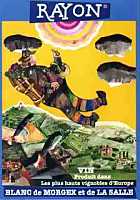
|
|
Vallée d'Aoste Blanc de Morgex et de La Salle Rayon 2002 |
|
| Cave du Vin Blanc de Morgex et de La Salle (Italy) | |
| Grapes: Blanc de Morgex | |
| Price: € 7,60 | Score: |
| A white of great elegance. The wine shows a beautiful brilliant greenish yellow color and nuances of greenish yellow, very transparent. The nose reveals good personality and a series of intense, elegant, very refined, clean and pleasing aromas of citrus fruit, pineapple, hawthorn, acacia, broom, litchi, apple, pear, peach and plum as well as a pleasing hint of anise. In mouth is very agreeable with a crisp attack well balanced by alcohol, intense flavors and excellent correspondence to the nose. The finish is very persistent with long and pleasing flavors of pear, peach, litchi and pineapple. A very elegant and well made wine. | |
| Food Match: Pasta and risotto with fish, Fish soup, Sauteed white meat, Soft cheese | |
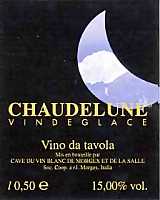
|
|
Chaudelune Vin de Glace |
|
| Cave du Vin Blanc de Morgex et de La Salle (Italy) | |
| Grapes: Blanc de Morgex | |
| Price: € 15,00 (500 ml - 16.9 fl.ozHard cheese, Confectionery, Dried fruit or almond tarts | Score: |
| The wine shows a light golden yellow color and nuances of straw yellow, very transparent. The nose has clean, pleasing, intense and elegant aromas of dried apricot, peach jam, almond, cooked apple, cooked pear, honey, candied fruit, citrus fruit peel and vanilla as well as an aroma of toasted wood. In mouth reveals good correspondence to the nose, a crisp attack however well balanced, intense flavors and smoothness. The finish is persistent with flavors of peach, honey and pear. Chaudelune is produced with grapes harvested at temperatures below zero and is fermented in barrique followed by a long aging in bottle. | |
| Food Match: Hard cheese, Confectionery, Dried fruit or almond tarts | |
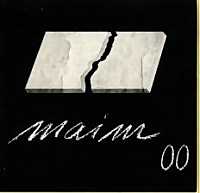
|
|
Garda Classico Groppello Maim 2000 |
|
| Costaripa (Italy) | |
| Grapes: Groppello | |
| Price: € 10,35 | Score: |
| The wine has a brilliant ruby red color and nuances of ruby red, moderate transparency. The nose reveals intense, clean and pleasing aromas of black cherry, blueberry, blackberry and plum followed by good aromas of vanilla where good aromas of wood are also perceived. In mouth denotes good correspondence to the nose, a slightly tannic attack however balanced, good body and intense flavors. The finish is persistent with flavors of black cherry, blueberry and plum. Maim Ages in cask for at least 12 months followed by at least 10 months of aging in bottle. | |
| Food Match: Stuffed pasta, Meat with mushrooms, Roasted meat, Broiled meat and barbecue, Hard cheese | |
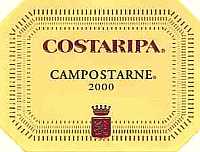
|
|
Garda Classico Campostarne 2001 |
|
| Costaripa (Italy) | |
| Grapes: Groppello, Marzemino, Merlot, Cabernet Sauvignon | |
| Price: € 5,00 | Score: |
| The wine shows a brilliant ruby red color and nuances of ruby red, moderate transparency. The nose denotes personality with intense, clean and elegant aromas of black cherry, raspberry, blueberry and plum followed by aromas of vanilla and violet as well as hints of smoke and toffee. In mouth reveals good correspondence to the nose, good balance and body as well as tannins in good evidence. The finish is persistent with flavors of raspberry, blueberry and plum. | |
| Food Match: Stuffed pasta, Roasted meat, Broiled meat and barbecue, Hard cheese | |
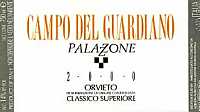
|
|
Orvieto Classico Superiore Campo del Guardiano 2000 |
|
| Palazzone (Italy) | |
| Grapes: Procanico (50%), Grechetto (25%), Verdello, Drupeggio and Malvasia Bianca (25%) | |
| Price: € 9,00 | Score: |
| The wine shows a beautiful light straw yellow color and nuances of greenish yellow, very transparent. The nose has intense, clean, elegant and pleasing aromas of hawthorn , broom, almond, apple, medlar, hazelnut, pear and peach as well as a pleasing hint of rosemary. In the mouth reveals good correspondence to the nose, a crisp and round attack however well balanced by alcohol, good body and intense flavors, agreeable. The finish is persistent with good flavors of apple, pear and peach. This Orvieto Classico is ages in bottle for 16-18 months. | |
| Food Match: Roasted fish, Crustaceans, Pasta and risotto with fish, Sauteed white meat, Soft cheese | |
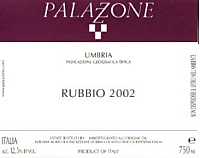
|
|
Rubbio 2002 |
|
| Palazzone (Italy) | |
| Grapes: Sangiovese (70%) Canaiolo, Montepulciano (30%) | |
| Price: € 7,00 | Score: |
| The wine shows a brilliant ruby red color and nuances of ruby red, moderate transparency. The nose reveals good personality with intense, clean, elegant and pleasing aromas of cherry, strawberry, raspberry and violet followed by pleasing aromas of rose as well as hints of peach. In mouth has good correspondence to the nose, a slightly tannic attack however balanced by alcohol, intense flavors and agreeable. The finish is persistent with pleasing flavors of raspberry and cherry. Rubbio ages for 6 months in barrique and for 2 months in bottle. | |
| Food Match: White roasted meat, Sauteed meat, Hard cheese | |
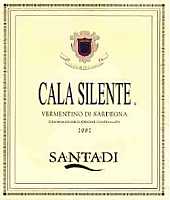
|
|
Vermentino di Sardegna Cala Silente 2002 |
|
| Santadi (Italy) | |
| Grapes: Vermentino | |
| Price: € 6,24 | Score: |
| The wine shows an intense straw yellow color and nuances of greenish yellow, very transparent. The nose reveals pleasing, intense and clean aromas of banana, broom, wistaria, kiwi, lemon, pear, apple, gooseberry followed by good aromas of fennel and vanilla. In mouth denotes good correspondence to the nose, good balance, intense flavors, agreeable. The finish is persistent with good flavors of apple, banana and pear. Cala Silente partly ages in barrique and partly in steel tanks. | |
| Food Match: Stuffed pasta, White meat, Fried vegetables, Fish, Soft cheese | |
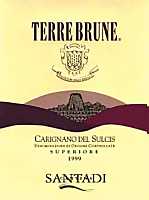
|
|
Carignano del Sulcis Superiore Terre Brune 1999 |
|
| Santadi (Italy) | |
| Grapes: Carignano (95%), Bovale (5%) | |
| Price: € 24,00 | Score: |
| The wine shows an intense ruby red color and nuances of garnet red, little transparency. The nose reveals personality with intense, elegant, clean and refined aromas, very pleasing, of strawberry jam, blackberry jam, peach jam, raspberry, blueberry, plum, iris and violet followed by good aromas of carob, vanilla, licorice and mint. In mouth denotes good correspondence to the nose, round and smooth, very balanced, full body and intense flavors. The finish is persistent with pleasing and clean flavors of plum, blueberry and peach jam. A well made wine. Terre Brune is aged for 15-18 months in barrique and for 12 months in bottle. | |
| Food Match: Roasted meat, Broiled meat and barbecue, Stewed meat, Hard cheese | |
|
||||||||
|
DiWineTaste Polls
|
| |||||||
Privacy Policy | |||||||


| Copyright © 2002-2024 Antonello Biancalana, DiWineTaste - All rights reserved |
| All rights reserved under international copyright conventions. No part of this publication and of this WEB site may be
reproduced or utilized in any form or by any means, electronic or mechanical, without permission in writing from DiWineTaste. |